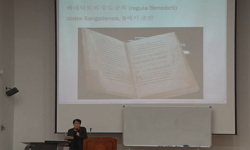This study shows the double-sidedness of Mari and Takahashi in “After Dark”, with a persecution complex, harmful behavior, problems implied by harmful behavior and the meaning of different endings. Due to her inferiority to her sister, Mari is cau...
http://chineseinput.net/에서 pinyin(병음)방식으로 중국어를 변환할 수 있습니다.
변환된 중국어를 복사하여 사용하시면 됩니다.
- 中文 을 입력하시려면 zhongwen을 입력하시고 space를누르시면됩니다.
- 北京 을 입력하시려면 beijing을 입력하시고 space를 누르시면 됩니다.

『애프터 다크(アフターダーク)』에 나타난 양면성현대사회와 인간 내면에 잠재된 중층성 고찰 = The double-sidedness in “After Dark” Consideration of the diversity lurking inside modern society and the human
한글로보기https://www.riss.kr/link?id=A103632493
- 저자
- 발행기관
- 학술지명
- 권호사항
-
발행연도
2016
-
작성언어
Korean
- 주제어
-
등재정보
KCI등재
-
자료형태
학술저널
-
수록면
227-246(20쪽)
-
KCI 피인용횟수
0
- DOI식별코드
- 제공처
- 소장기관
-
0
상세조회 -
0
다운로드
부가정보
다국어 초록 (Multilingual Abstract)
She returns home and feels guilty to Eri and tears, but Takahashi still wanders around the dark streets. In other words, the figure of Mari ,who recognized her harmful behavior, shows the possibility of communication with the other, but the figure of Takahashi, who does not, passes the message that the problem will appear again in another form unless the problem is solved. The double-sidedness and the two different conclusions can be seen as a setting that Haruki Murakami intended to objectively show the reality in order to “provide readers with the multiple possibilities”. In other words, he wanted to depict the ambiguous meaning inherent in the human and society that he felt after the incident of Aum Shinrikyo.
This study shows the double-sidedness of Mari and Takahashi in “After Dark”, with a persecution complex, harmful behavior, problems implied by harmful behavior and the meaning of different endings. Due to her inferiority to her sister, Mari is caught up in a victim mentality even h after she becomes an adult. She makes a hobby of torturing herself. Takahashi cannot recover his relationship with his parents because of his grudge against his father. These two people are obsessed with the victim mentality and take the attitude of a bystander who turns away from Eri's “silent cry” represented by others. However, they recognize their problems through the process of knowing each other. However, they arrive at different endings.
She returns home and feels guilty to Eri and tears, but Takahashi still wanders around the dark streets. In other words, the figure of Mari ,who recognized her harmful behavior, shows the possibility of communication with the other, but the figure of Takahashi, who does not, passes the message that the problem will appear again in another form unless the problem is solved. The double-sidedness and the two different conclusions can be seen as a setting that Haruki Murakami intended to objectively show the reality in order to “provide readers with the multiple possibilities”. In other words, he wanted to depict the ambiguous meaning inherent in the human and society that he felt after the incident of Aum Shinrikyo.
참고문헌 (Reference)
1 권택영, "현대 문명의 이면에 가려진 몸의 실존적 의미, 어둠의 저편" 문학사 280-297, 2005
2 村上春樹, "解題. 村上春樹全作品 1990∼2000 約束された場所で、村上春樹、河合隼雄に会いにいく, 7" 講談社 377-395, 2003
3 清水良典, "終章 鏡よ、鏡よ!『アフターダーク』. 村上春樹はくせになる" 朝日新聞社 207-232, 2006
4 土居豊, "第3章 アフターダークからはじまる新時代の論理─暴力の系譜. いま、村上春樹を読むこと" 関西学院大学出版会 58-78, 2014
5 村上春樹, "目じるしのない悪夢. 村上春樹全作品 1990∼2000 アンダーグラウンド, 6" 講談社 637-673, 2003
6 河合隼雄, "河合隼雄のベストセラー診断 村上春樹『アフターダーク』にみる「コミットメントの条件」" 39 (39): 94-101, 2005
7 吉原千明, "村上春樹論--『アフターダーク』にみる救い" 17 : 63-70, 2008
8 渥美孝子, "村上春樹『アフターダーク』の居場所--アダルト・チルドレンと 監視社会と" 28 : 97-111, 2008
9 岩宮恵子, "思春期体験と現実の多層性--村上春樹『アフターダーク』から(特集 ファンタジーの世界)" 7 (7): 115-120, 2006
10 村上春樹, "これだけは、村上さんに言っておこう" 朝日新聞社 2006
1 권택영, "현대 문명의 이면에 가려진 몸의 실존적 의미, 어둠의 저편" 문학사 280-297, 2005
2 村上春樹, "解題. 村上春樹全作品 1990∼2000 約束された場所で、村上春樹、河合隼雄に会いにいく, 7" 講談社 377-395, 2003
3 清水良典, "終章 鏡よ、鏡よ!『アフターダーク』. 村上春樹はくせになる" 朝日新聞社 207-232, 2006
4 土居豊, "第3章 アフターダークからはじまる新時代の論理─暴力の系譜. いま、村上春樹を読むこと" 関西学院大学出版会 58-78, 2014
5 村上春樹, "目じるしのない悪夢. 村上春樹全作品 1990∼2000 アンダーグラウンド, 6" 講談社 637-673, 2003
6 河合隼雄, "河合隼雄のベストセラー診断 村上春樹『アフターダーク』にみる「コミットメントの条件」" 39 (39): 94-101, 2005
7 吉原千明, "村上春樹論--『アフターダーク』にみる救い" 17 : 63-70, 2008
8 渥美孝子, "村上春樹『アフターダーク』の居場所--アダルト・チルドレンと 監視社会と" 28 : 97-111, 2008
9 岩宮恵子, "思春期体験と現実の多層性--村上春樹『アフターダーク』から(特集 ファンタジーの世界)" 7 (7): 115-120, 2006
10 村上春樹, "これだけは、村上さんに言っておこう" 朝日新聞社 2006
11 村上春樹, "『悪』を抱えて生きる. 村上春樹全作品 1990∼2000 約束された場所で、村上春樹、河合隼雄に会いにいく, 7" 講談社 211-233, 2003
동일학술지(권/호) 다른 논문
-
스마트폰을 활용한 동영상 촬영과 자가평가 활동이 영어프레젠테이션 향상에 미치는 영향
- 중앙대학교 외국학연구소
- 송은혜
- 2016
- KCI등재
-
성인 영어 코퍼스와 아동 영어 코퍼스의 어휘 사용 비교·분석
- 중앙대학교 외국학연구소
- 신동광
- 2016
- KCI등재
-
한국어 어휘의 어원 연구 - 상고 중국어음을 통한 분석
- 중앙대학교 외국학연구소
- 김태경
- 2016
- KCI등재
-
鮑照 <擬行路難>의 구성방식과 화법 분석 - 擬樂府體 組詩의 성격을 중심으로 -
- 중앙대학교 외국학연구소
- 채미현
- 2016
- KCI등재
분석정보
인용정보 인용지수 설명보기
학술지 이력
| 연월일 | 이력구분 | 이력상세 | 등재구분 |
|---|---|---|---|
| 2022 | 평가예정 | 재인증평가 신청대상 (재인증) | |
| 2019-01-01 | 평가 | 등재학술지 유지 (계속평가) |  |
| 2016-01-01 | 평가 | 등재학술지 유지 (계속평가) |  |
| 2013-04-22 | 학회명변경 | 영문명 : FOREIGN STUDIES CENTER -> FOREIGN STUDIES INSTITUTE |  |
| 2012-01-01 | 평가 | 등재학술지 선정 (등재후보2차) |  |
| 2011-01-01 | 평가 | 등재후보 1차 PASS (등재후보1차) |  |
| 2009-01-01 | 평가 | 등재후보학술지 선정 (신규평가) |  |
| 2007-09-03 | 학회명변경 | 한글명 : 외국어문학연구소 -> 외국학연구소 |
학술지 인용정보
| 기준연도 | WOS-KCI 통합IF(2년) | KCIF(2년) | KCIF(3년) |
|---|---|---|---|
| 2016 | 0.28 | 0.28 | 0.25 |
| KCIF(4년) | KCIF(5년) | 중심성지수(3년) | 즉시성지수 |
| 0.22 | 0.2 | 0.437 | 0.12 |




 KCI
KCI



